|
|
|
|
|
|
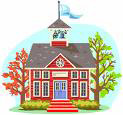
Memphis City Schools:
1859-1876 |
|
|
|
|
The first Memphis schools were chartered in 1826 but until 1848
all the city schools were private. By 1855, there were 19 "free"
schools with 1108 pupils. In 1856 Mr. P. H. Davies was teacher at
Senior Male School and Mrs. Annie C. Bradford was teacher at the Senior
Female School. The earliest Memphis directory, from 1859, shows that Memphis was divided into
"Wards" and the schools in the various Wards were simply named "No. 1, No.
2, etc". The 1859 directory is reproduced below. During the
Civil War, the Memphis schools remained open and with the exception of the
Senior Male School, attendance continued to rise. In 1864-65
provisions were made for maintaining public schools for "colored children"
and incorporating them into the school system. In 1866 all of the "free"
and private schools were incorporated into The Memphis City Schools.
|
Buildings were generally inadequate for school purposes. In 1870 a lot
was purchased on the corner of 3rd and Market, and the first "real
school house" was erected in Memphis, at a cost of $80,000. This was the old
Market Street School, which will be part of the Memphis City Schools until
1946. The lower floor of 4 classrooms was for
elementary classes and part of the 2nd floor was for high school. |
 |
1875
Commencement Exercises Programme
Featured on this page is a commencement program from 1875.
It is the oldest known Memphis City Schools Commencement Program in
existence. Thanks to historian Rob Jolly for sharing it with this
website. This 1875 Commencement was held at the Greenlaw Opera
House, across from the Peabody on 2nd and Union. The
Opera House burned in 1883 and was not rebuilt.
This website has found two printed accounts of this 1875 Commencement in the
archives of Memphis newspapers. Both of them are reproduced below.
|
|
|
|
Click on small photos below to see large photos. |
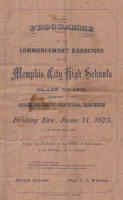 |
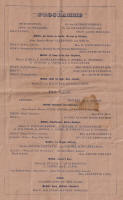 |
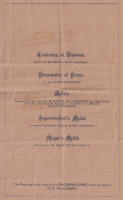 |
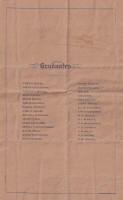 |
|
Cover |
Inside Left |
Inside Right |
Back |
|
| |
|
|
The two schools graduating in this program are "Male High School"
and "Female High School". The male school was
the Adams Street School at 300 Adams. The female school was
the Court Street School at Court and 3rd. Within two years they will be
combined as the "Memphis High School". T. C.
Anderson, principal of the Adams Street School will become principal
of the Memphis High School. Both the male and the female
schools are listed in the Memphis Directories of 1872. That
directory is reproduced below, as well as an older newspaper article
showing the Male-Female high schools go back at least as far as
1867.
Look at the bottom of the program cover for the name Miss Jennie M.
Higbee, principal of the Female High. The following year she started the Higbee School.
There is a memorial in Overton Park for Miss Higbee and a street was
named after her. On page 3 of the commencement, you'll see the name of Mrs.
Crockett, who presented medals at the ceremony. That is Mrs. E. J.
Crockett who became the #2 teacher at Memphis High School and
eventually principal, for many years. This information is also
documented in the Memphis Directories of 1875 up to 1883. This
website has confirmed that Crockett Technical School was named in
honor of Mrs. E. J. Crockett.
|
|
Below are some interesting newspaper articles. Click on
fragments for an enlargement of the entire article.
|
|
|
|
| Below:
An article reviewing the 1875 Commencement at the Greenlaw
Opera House. |
|
| Below:
Another article reviewing the 1875 Commencement at the
Greenlaw Opera House. |
|
| |
|
 |
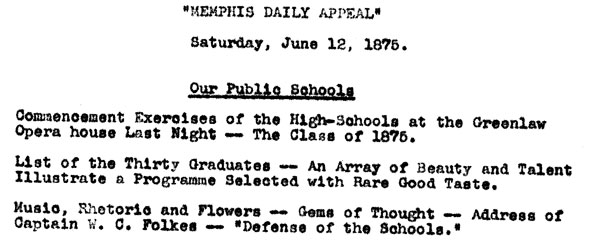 |
| |
|
| |
|
|
Below: Memphis
Ledger shows the Male High and Female High
Schools go back as far as 1867. |
|
|
Below: 1872 Memphis
Directory listing Adams Male High School and Court Street Female High
School |
|
| |
|
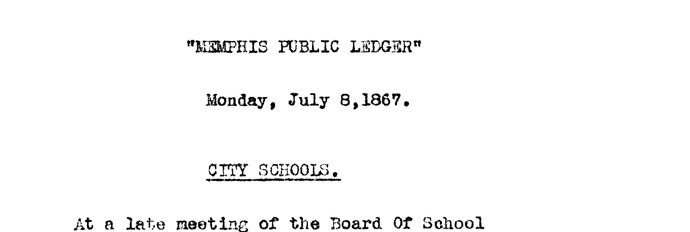 |
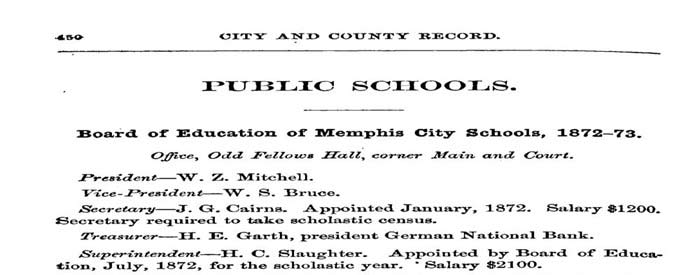 |
| |
|
| |
|
|
Below: 1859
Directory showing Memphis was divided into Wards and the
schools are numbered, rather than named. |
|
|
Below: Memphis
Directory
showing that the Numbered school names continued at least thru 1866. |
|
| |
|
 |
 |
| |
|
| |
|
|
Below: 1883 Memphis
Directory listing Mrs. E. J. Crockett as Principal of Memphis High School |
|
|
| |
|
 |
|
|
|
|
|
| |
|
GREENLAW OPERA HOUSE
|
|
(Note: We have not
been able to secure a photo of the Greenlaw Opera House.
Neither the Public Library archives nor the Memphis State University
archives can locate one. The full history of the Greenlaw Opera
House is reproduced at the bottom of this page). |
|
Historical marker
for the Greenlaw Opera
|
For some strange reason, this marker for the Greenlaw Opera house is
in an alley around the corner from where the Opera House was
located. |
|
|
|
Click
on the photo to read NY Times article about "the fire:.
> |
|
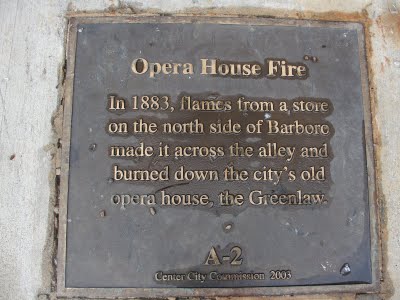 |
|
|
|
|
|
Below: An 1883
description of the Greenlaw from "The American Plague", Part II Memphis
1878 - Carnival, by Molly Caldwell Crosby.
|
|
|
|
1883 "… As the parade marched
by Adams and Second, the First Baptist Church held a lecture on the
temperance movement. When the floats passed, the ministers stood outside
signing up new volunteers for their “red Ribbon brigade.” All of this
mattered little to the Ulks and their throngs who made their way to the
Greenlaw Opera House on the corner of Union.
The Romanesque Greenlaw had seen better days. The four story opera house
had been built with greatness in mind: a ballroom that could accommodate
300 couples; an opera house with 8 foot wide doors operated by pulleys and
counterweights; an auditorium with fifty foot ceilings. Its builders had
visions of the country’s finest musicians, theater and modern lectures.
But by 1878, it had become a nickel-and-dime hall whose main lectures were
those of the temperance movement. Instead of violin concertos, patrons
heard a man play his cornet imitations and listened to a sermon on the
temperance cause. That year, Mardi Gras breathed a little life and
sophistication back into the Greenlaw.
The
Greenlaw had been decorated like a childhood fairyland with evergreens,
hundreds of imported flowers and caged canaries. A revolving pyramid,
three tiers high, repeated the themes of the parade floats. The newspaper
reported that “fans fluttered and diamonds flashed.” In fact, the only
drawback to the evening seemed to be the number of ladies carrying stylish
feather fans, which as they quivered, set off tufts of fleecy clouds all
over the room. To the intoxicated revelers, it must have seemed like part
of the magic". |
|
|
|
Below:
Click on the fragment to read a complete history of the Greenlaw Opera House
in PDF format. It's a big file, please be patient while it loads.
Please use BACK BUTTON to return to this page. |
|
|
|
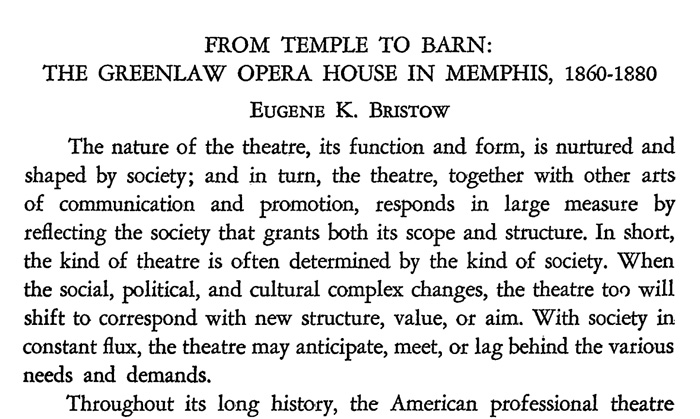 |
|
|
|
|